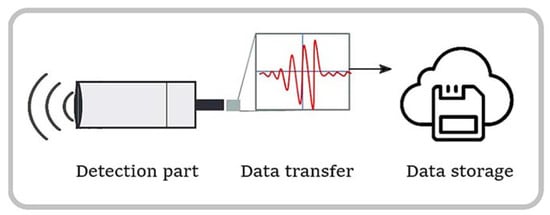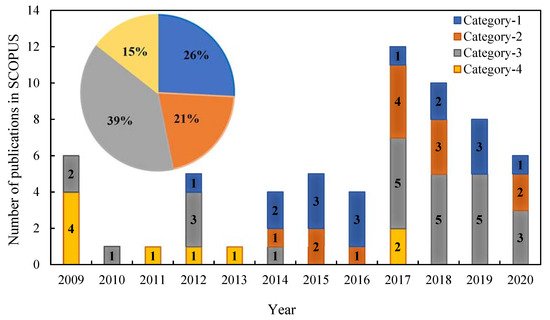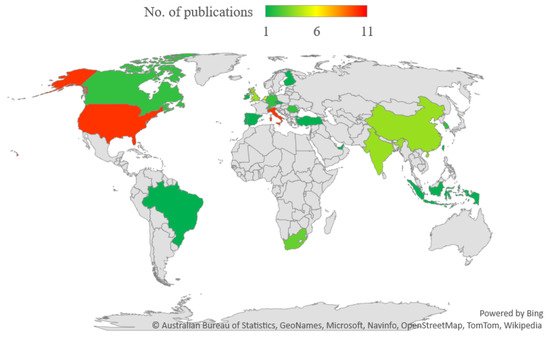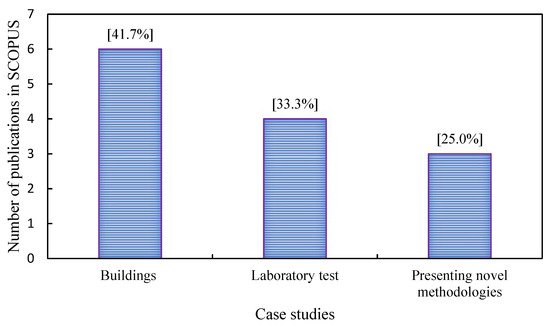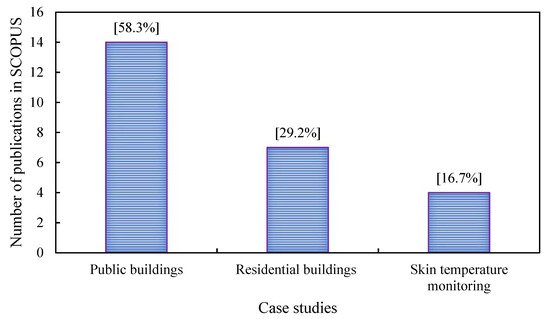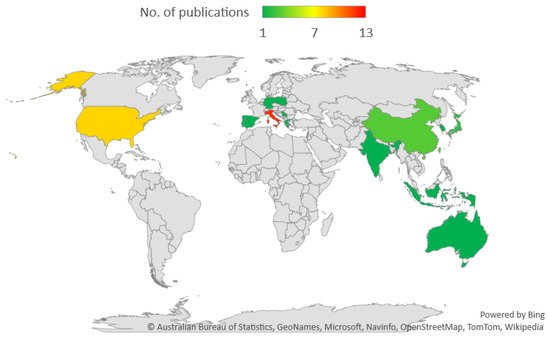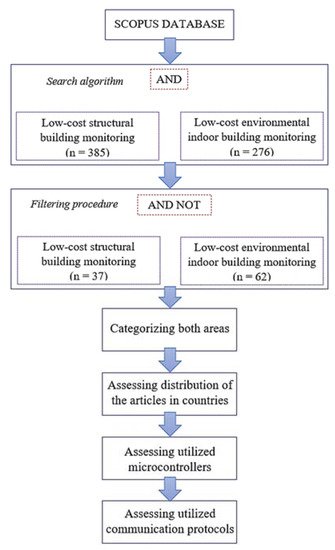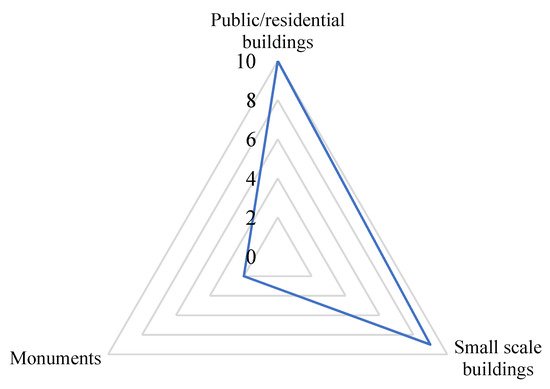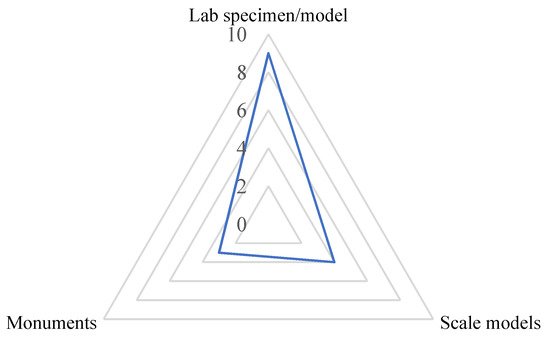In recent years, many scholars have dedicated their research to the development of low-cost sensors for monitoring various parameters. Despite their high number of applications, the state of the art related to low-cost sensors in building monitoring has not been addressed. To fill this gap, this article presents a systematic review, following a well-established methodology, to analyze the state of the art in two aspects of structural and indoor parameters of buildings, in the SCOPUS database. This analysis allows to illustrate the potential uses of low-cost sensors in the building sector and addresses the scholars the preferred communication protocols and the most common microcontrollers for installation of low-cost monitoring systems. In addition, special attention is paid to describe different areas of the two mentioned fields of building monitoring and the most crucial parameters to be monitored in buildings. Finally, the deficiencies in line with a limited number of studies carried out in various fields of building monitoring are overviewed and a series of parameters that ought to be studied in the future are proposed.
1. Introduction
Building monitoring has become a matter of concern for engineers and architects as structures and building envelopes should meet the safety, habitability, and sustainability requests during the service life
[1][2]. Accordingly, engineers decided to control the performance of the buildings by monitoring two main parameters: (1) Structural parameters: in terms of structural system identification (SSI), some numerical approaches have been developed for inferring mechanical parameters of structures modeled with 1D elements (such as steel and concrete buildings, cable-stayed bridges, trusses, and frames)
[3][4][5], 2D elements (such as tunnels, culverts, and dams)
[6], and 3D elements
[7]. In terms of deriving parameters of structures modeled with 3D elements, various approaches have been presented in the literature
[8][9]. For instance, Mobaraki and Vaghefi developed 3D finite element models to measure peak pressure and the peak particle velocity (PPV), at critical points of 4 cross-sectional shapes of the tunnel (box shape, circular shape, horseshoe shape, and semi-ellipse shape)
[10]. Lyapin et al. introduced a methodology for monitoring buried structures of arbitrary cross-sections, located in layered media, affected by different external dynamic loads
[11]. They developed an analytical approach for the determination of resonance zones and the dynamic response of structures. In addition, they conducted an experimental study for measuring acceleration at the ceiling center point of an underground pedestrian road in Russia. A review of research carried out in the field of SSI was presented by Sirca Jr. and Adeli
[12]. The methodology for identification of modal parameters in historical building using stochastic subspace identification algorithm was carried out by Bianconi et al.
[13]. Markiewicz et al. utilized a geo-localization approach to specify the location of the structural monitoring system that allowed to geo-reference the measurements carried out by the sensors. This analysis is useful for data processing related to the monitored structure and its features
[14]. Applicability of strain gauge to real-time monitoring of wood behavior carried out was carried out by Anaf et al. in a church where a new heating system was installed
[15]. For structural safety assessment, as well as calibration of the structural models, measurements of acceleration, and deflection at different parts of buildings are needed. There are varieties of measurement devices in the market for the measurement of the mentioned parameters. The price of these devices is normally high as they contain expensive sensors, a data treatment protective box, a power system, and software for data acquisition systems. According to the report published by BBC research center, the size of the global sensors market has dramatically increased since 2011
[16]. It can be said that this market was valued at USD 101.9 billion in 2015 and by considering a compound annual growth rate of 11.0% will reach to USD 190.6 billion by 2021. (2) Indoor building parameters: One of the principal indoor parameters to be monitored is the energy efficiency of building
[17]. In terms of controlling this parameter, diverse methodologies have been proposed for characterization of thermal parameters of the buildings. Traditionally, it was necessary to core the building envelope, measure the thickness of each layer and after assigning conductivity value to each layer, the transmittance parameter of the object could be inferred. To avoid implementation of the destructive approaches to the buildings, several methodologies were developed for thermal parameter diagnosis of the buildings. The functionality of these approaches is normally based on costly measurement of the ambient temperature, surface temperature, and heat flow rate through the object. Accurate estimation of these parameters requires multiple measurement points on the structures. However, due to the expensive instrumentation of these methodologies, only a single measurement point is considered by engineers to determine the condition of the structure
[18]. A review of the current expensive methodologies for thermal monitoring of the buildings can be found in the article of Teni et al.
[19].
In this regard, there are multiple codes for defining a set of guidelines to be considered in different types of building energy performance. Some of the common monitoring standards in Europe are as follows: (1) EN 15232 provides the requirements for the building automation, control, building management functions exerted to various types of buildings, and the effect of different functions on the energy performance of buildings. (2) ISO 16739-1:2018 is a standard for building information modeling (BIM). This standard provides BIM exchange format definitions that are needed during the life cycle of buildings and are required by diverse disciplines (e.g., architecture, project management, and building service). (3) ISO 6946:2017 for theoretical calculation of the thermal transmittance parameter (U-value) of the buildings, by considering the thicknesses of the wall’s compositions (4) ISO 9869: 2014 presents the heat flux meter (HFM) method for calculation of the thermal transmission of the buildings’ components under a steady-state condition (although this situation cannot be achieved from the physical-mathematical point of view). (5) ISO 6781-3:2015 detection of heat, air, and moisture irregularities in buildings by infrared methods. (6) ISO 10456:2007 presents the methods for the calculation of the thermal parameters of the buildings by introducing the thermal conductivity of different materials. Among the explained standards, numbers (1) and (4) present multiple provisions, such as tests duration, frequency of the observations, seasonality of experiments, treatment of the outliers, and verification methods of the observations.
The development of a building monitoring system (BMS) requires the installation of a data acquisition system for real-time observation of parameters and a network for storing the data
[20]. Unfortunately, due to the complexity of the sensors, traditional BMS is not an easy task as it entails specialized programming and maintenance of the system. In this way, various monitoring systems have been produced by companies for direct supervision of building performance. As depicted in
Figure 1, a common monitoring system contains three main parts. (1) A detection part. This part contains a sensor or data acquisition system to measure the events and changes of a parameter. (2) Data transfer system. This part is used to transmit readings from one place to another through a communication method and (3) storage part. This part consists of a component to keep the digital data.
Figure 1. Schematic of a data acquisition system.
After saving and processing the data, the principal objective is to assess the workability of the building and the safety of the habitants. Recently, diverse technologies have been developed with the purpose of real-time monitoring of buildings and safety management of people. In fact, the most flourishing technology for this aim is BIM. This tool is a novel approach to monitor, analyze, design, and manage safety, wherein visualization of the building state is utilized to enable the exchange and interoperability of data. BIM has been adopted by CAD software such as Autodesk Revit
[21], ArchiCAD
[22] and Allplan
[23]. In 1900s Matilla et al. studied the significance of studying the connections between management and safety
[24]. Research of Ding et al. indicated that the quantity of the published articles on BIM from the perspective of safety management is 7%. The other advanced technology that brought the great potential for the safety management of people is the wireless sensor network (WSN). With cheap, low-power consumption, and dynamic networking characteristics, WSNs are a good option for the collection of environmental and structural information of buildings and return it to visualizing unit for safety management and risk analysis
[25]. Cheung et al. integrated BIM and WSN into a single system to visualize the construction site, monitor the safety level through an interface, and remove the risk or danger of the gas automatically
[26]. They have also carried out safety management processes of underground structures by monitoring the other elements of environmental parameters, such as temperature and humidity. They installed the sensor nodes at different locations of the structure, and in any area where an abnormal situation is realized, the BIM model alarms the area, and ventilator starts working, automatically.
Table 1 presents a list of common environmental monitoring devices in the market providing the products’ name, detection range, accuracy, cost, and the reference of their applications in the literature.
Table 1. List of commercial systems in the market for indoor monitoring of buildings.
| Application |
Device |
Detection Range |
Accuracy |
Price (€) |
Ref. |
| Temperature |
PROTMEX MS6508 |
−20 to 60 °C |
1.0 °C |
57 |
[27] |
| REED R6001 |
−20 to 60 °C |
0.8 °C |
103 |
[28] |
| FLUKE 971 |
−20 to 60 °C |
0.5 °C |
464 |
[29] |
| EL-USB-2 LASCAR |
−35 to 80 °C |
0.5 °C |
57 |
[30] |
| TESTO 435-1 thermocouples class 1 |
−50 to 150 °C |
0.2 °C |
1032 |
[31] |
| EXTECH EN510 |
−100 to 1300 °C |
0.1 °C |
180 |
[32] |
| Gas |
NDIR |
0–10,000 ppm |
30–200 ppm |
80–550 |
[33] |
| MOSFET |
400–20,000 ppm |
30–100 ppm |
20–2300 |
[34] |
| Electrochemical |
0–1000 ppm |
0–30 ppm |
85–620 |
[35] |
| Humidity |
Captive sensors |
0–100% RH |
0–5% |
30–180 |
[36] |
| Resistive sensors |
5–90% RH |
1–10% |
30–140 |
[37] |
| Airflow |
Hot wire Anemometer |
0.1–45 m/s |
1–5% |
45–190 |
[38] |
| Vane Anemometer |
0.25–50 m/s |
1–5% |
30–280 |
[39] |
In terms of structural monitoring, there are various tools to measure different parameters such as acceleration, strain, and stresses. Accelerometer is an electromechanical device that determines the acceleration forces imposed to or acting on an object. There are varieties of accelerometers that work based on a different mechanism such as (1) Piezoelectric, this type of accelerometer uses the piezoelectric effect of specific material and transforms a type of energy into another one and produce an electrical signal in response to a parameter is being measured. (2) Piezoresistive, this type of accelerometer generates resistance changes in displacement sensor which is part of accelerometer system. This type of accelerometer is the best option for measuring impulse where the amplitude and frequency range is high. (3) Capacitive micro electro mechanical system (MEMS), for construction of this type of accelerometer, MEMS technology is being used and works according to capacitance changes in a seismic mas under acceleration.
Table 2 provides examples of the mentioned types of accelerometers in the market (including both and high frequency) providing the mechanism, the name, acceleration range, frequency range, and the references in the literature. The accelerometers utilized for measuring specific human activities, transportation, and mechanical devices must be developed especially for low frequency and high sensitivity, range from 1 to 10 Hz
[40]. Tian et al. developed a piezoelectric accelerometer on n-type single crystal silicon and examined the sensor in terms of maximum stress, natural frequency, and output voltage under acceleration through the finite element method. The sensitivity of the developed accelerometer was 9
mV/g, the linearity was 0.0205, and the hysteresis was 0.0033
[41]. Another example of low-frequency piezoelectric accelerometers in the literature is
[42][43]. Liu et al. proposed a novel low-frequency fiber bragg grating (FBG) accelerometer with a bent spring plate. The experiments showed the sensitivity of the accelerometer was more than 1000
pm/g when the frequency is within 0.7 to 20 Hz
[44]. Another example of low-frequency FBG accelerometers can be found in
[45][46][47]. Zhu et al. designed a high resolution, low frequency and low-noise tri-axial digital MEMS accelerometer for monitoring large-scale civil infrastructures
[48]. Examples of the other low-frequency MEMS accelerometers were presented in
[49][50].
Table 2. Example of common accelerometers in the market.
| Mechanism |
Device |
Acceleration Range(g) |
Frequency
Range (KHz) |
Price (€) |
Ref. |
| Capacitive |
IAC-HiRes-I-03 |
±25 |
0–10 |
2230 |
[51]
[52]
[53]
[54] |
| MS9002 |
±2 |
0–2 |
286 |
| MS9010 |
±10 |
0–10 |
286 |
| MS9050 |
±50 |
0–50 |
286 |
| MS9100 |
±100 |
0–100 |
286 |
| MS9200 |
±200 |
0–200 |
571 |
| Piezoelectric |
3713B112G |
±2 |
0–25 |
2070 |
[55]
[56] |
| Dytran 3143D1 |
±50 |
0.0005–3 |
1255 |
| Dytran 3093B |
±50 |
0.006–5 |
1255 |
| Dytran 3263A14 |
±250 |
0.0005–4 |
1255 |
| Dytran 3093M27 |
±500 |
0.0033–3 |
1525 |
| |
Dytran 3093M18 |
±500 |
0.007–5 |
1525 |
|
| Piezoresistive |
3501A2020KG |
±20,000 |
0–10 |
960 |
[57] |
| 3503C2060KG |
±60,000 |
0–10 Hz |
6750 |
| 3991B1120KG |
±20,000 |
0–10 Hz |
2500 |
Demands for efficient and low-cost monitoring of the buildings are continuing to increase
[58]. This matter can be the first step to reduce the uncertainty of building monitoring by increasing the density of measurement points
[59]. With the quick increase in microsensor technology and jutting microcontrollers (e.g., Arduino and raspberry), the quick adoption of the low-cost sensors (LCS) for various aspects of building monitoring can be seen in the literature
[60]. The example of these studies are monitoring of: temperature
[61], humidity
[62], light
[63],
CO2 [64], particle matter
[65], airflow
[66], occupancy
[67], energy consumption
[68], electricity and window opening times
[69], solar irradiance
[70], solar heat flux
[71], strain
[72], acceleration
[73], and for detecting the earthquake
[74], triaxial acceleration
[75].
2. Results on Low-Cost Sensors for Building Monitoring
The first publications found in the SCOPUS presenting the idea of using LCSs dealing with indoor monitoring of buildings and structural ones are both dated in 1993 (these two articles were not considered in the statistical analysis of this research as they were introducing the idea of utilizing low-cost sensors (e.g., fiber optic sensors) in building monitoring). Measures evaluated the types of low-cost strain optic sensors and he approved the applicability of Bragg grating which had satisfied the requirements for smart structures, due to the developed ratiometric wavelength demolition system
[76]. Tsilingris presented a low-cost flat-response, temperature compensated sensor designed for measuring the radiation transmission, that can be used for underwater uses and solar ponds
[77].
Figure 2 illustrates the significant of LCSs in the articles found in the SCOPUS database from 2006 to 2020. It can be observed in the figure that from 2006 until 2013 the number of publications associated with the use of LCS for structural monitoring is negligible (27%) and more than 73% of the articles have been published in the last 7 years (from 2014 to 2020). This rebound in terms of projects dealing with indoor monitoring of buildings occurred at the same time as the number of publications has the share of 77.4% in the last 7 years and only 22.6% of them were conducted in the first 8 years.
Figure 2. Distribution of the reviewed articles from 2006 to 2020 in the SCOPUS database.
2.1. Indoor Monitoring of Buildings
In this section, the reviewed articles associated with low-cost monitoring of buildings in terms of indoor parameters are presented. This first group of articles can be categorized into four separate categories. Category 1 is a group of authors that dedicate their studies on the application of LCSs to measure the efficiency of the electrical appliance and lessen the whole energy consumption of the buildings, category 2 are a group of authors that focus on controlling the air quality of the buildings through the measurement of the CO2, pollutant emission and aerosol nanoparticles, category 3, are a group of authors that address the thermal comfort and satisfaction of the buildings’ habitants by measuring the indoor temperature and humidity in their studies. This category also contains HVAC. Finally, category 4 contains publications dealing with special parameters of building monitoring such as fire and chemical detection, low-cost thermal monitoring of buildings, and the other parameters.
Figure 3 illustrates the distribution of the reviewed articles in SCOPUS associated with the above-outlined categories. It can be seen among the four categories, the highest number of published articles were dealing with the application of LCSs for thermal comfort monitoring of the building habitats and HVAC (Category-3). This group contains 39% of the publications from 2009 to 2020. The analysis of
Figure 3 proves that concerns with thermal comfort and indoor satisfaction of the people are significantly growing with time as the majority of the publications (75%) in this area are from the last four years. The majority of the electrical energy in the world consumes in building and industry rather than other sectors such as transport, fishing, and agriculture
[78]. Analysis of
Figure 3 shows that the distribution of the publications dealing with low-cost control of electricity consumption (category 1) in the building was almost constant during the years (from 2012 to 2020) and no significant change has occurred. This group of articles contains 26% of the publications in the field of indoor monitoring of buildings.
Figure 3. Distribution of the reviewed articles associated with the application of LCSs for indoor monitoring of buildings from 2009 to 2020. Category-1: Energy efficiency of the electrical appliance, category-2: controlling of the air quality and the pollutions, category-3: thermal comfort and HVAC, and category-4: other aspects of indoor monitoring of buildings.
In fact, the growth of industrialization in the world has caused an increase in pollutant emissions in cities. Simultaneously, the demand for controlling the air quality in buildings is increasing. Category 2 (controlling the indoor air quality and the level of indoor pollution) contains 21% of the whole publications in the SCOPUS database. The last group of the articles has a share of 15% in the whole reviewed article. Those papers described different investigations from the first three groups such as low-cost controlling of water consumption, low-cost monitoring of the chemical pollution, low-cost fire detection in the buildings, and low-cost thermal parameter diagnosis of building envelopes.
This section of the systematic review (monitoring indoor parameters of buildings) contains 62 publications from 24 countries. Figure 4 illustrates the distribution of publications from various parts of the world. In general, 16.1% of publications were executed in the United States and Italy each (10 articles each), 8.1% were reported from Netherlands (5 articles). 6.5% were published from India, United Kingdom, and China each. Another 5% were published from South Africa (3 articles). In addition, 3.2% were reported from Romania, Korea, Germany, Canada, and Switzerland each (2 articles). Taiwan, United Arab Emirates, Portugal, Spain, Indonesia, Czech Republic, Singapore, Brazil, Finland, Turkey, Bangladesh, and Ireland have the share of 1.6% each, from the whole 62 reviewed publications.
Figure 4. Distribution of the articles associated with indoor monitoring of buildings using low-cost sensors.
2.1.1. Energy Efficiency of the Electrical Appliance (Category 1)
This sub-section provides detailed information of the reviewed articles connected with category 1, low-cost monitoring of the electrical energy consumption in buildings. Electricity is one of the fields of energy that has a higher range of annual statistical reports (in the news) in the world than the other sources of energy such as coal, natural gas, oil, and renewables
[79]. According to the reports, since 1974 the global electricity consumption has raised year by year continuously except in 2008 and 2009 when the worldwide economic crisis occurred
[78]. Electrical energy efficiency in buildings can be defined as diminution in the power consumption of electrical devices/appliances without changing the normal life of the habitants. In fact, one of the most common ways in the literature to adjust the energy consumption is the visualization of occupancy information through different technologies, such as webcam, microphone, infrared-red sensor, proximity sensor, air temperature, and humidity sensor, light sensor, passive infrared sensor, occupancy sensor,
CO2 sensor, and acoustic sensor. For instance, Cheng et al.
[80], Longo et al.
[81], Pereira et al.
[82], Monti et al.
[83], Labeodan
[84], Foster et al.
[85], Zhao et al.
[86], Lan et al.
[87], Paci et al.
[88], and Chen and Ahn
[89], deployed occupancy sensors in the room to detect the people presence to reduce the energy consumption. Vanus et al.
[90] installed a
CO2 detection sensor to obtain information on the occupancy of the building. Dedesko et al.
[91] presented a dual-sensor methodology (
CO2 concentration sensor and non-directional doorway beam-break sensor) to provide a low-cost and accurate estimation of occupancy in the buildings. For detecting indoor activities, Nguyen and Aiello utilized a low-cost acoustic sensor
[92]. Wang et al. used dynamic spatial occupancy distribution (DSOD) as a new technique to infer occupancy distribution through a low-cost Bluetooth energy network. Newsham et al. mounted a low-cost webcam and microphone to present an accurate indoor occupancy sensing
[93]. For optimal estimation of occupancy based on the data of the light LCSs, Chen et al. used Bayes filter with neural network
[94]. Chaney et al. used the data extracted from temperature and
CO2 sensors to estimate building occupancy
[95], controlling the house appliance for the energy efficiency of the building through low-cost internet protocol presented in
[63].
2.1.2. Controlling of the Air Quality and Pollution (Category 2)
The four principal indoor air pollutants are asbestos, radon, and carbon dioxide. However, the whole reviewed publications in this area were focused only on low-cost detection of the aerosol and CO2 in the buildings. In this category (category 2), thirteen of the reviewed articles were focusing on indoor air pollution to improve the overall health of the occupants. According to the field test, the reviewed articles in this category can be classified into three groups. (1) a group of articles implementing the monitoring devices in different types of buildings such as educational, historical, residential, and laboratory. (2) a group of articles that used laboratory prototypes for calibration of their monitoring system. (3) a group of articles that did not explicitly determine the case studies but reported the methodology for the development of the low-cost CO2 sensing devices. Figure 5 provides information about the percentages distribution of the 3 groups of articles dealing with controlling the air quality and pollutions in buildings.
Figure 5. Classification of the articles associated with controlling of the air quality and the pollutions inside buildings. Group 1: focusing on building sector, group 2: conducting laboratory experiments, and group 3: presenting novel methodologies.
It is worthwhile to note that, 41.7% of the investigated articles, carried out field assessments of indoor air quality in educational buildings
[96], historical buildings
[97], residential buildings
[98][99], and laboratory buildings
[100]. One-third of the authors used laboratory prototypes for calibration of the sensors. For instance, Lachhab et al. proposed a wireless sensor network for indoor and outdoor monitoring of
CO2. To do so, they developed a prototype in the laboratory and controlled the function of the ventilation system
[101]. Herrick et al. presented an initial evaluation of the
CO2 sensor in a testing chamber
[102]. Examples of assessing the precision of the low-cost particle sensors based on the light scattering in a glass chamber can be found in
[65][103]. The remaining publications in group 3 did not clearly state their case study as they dedicated their study to describe the development of the low-cost
CO2 sensing system based on the nanofibers
[104], wireless sensor
[105], and hot-wire
CO2 sensor in CMOS technology
[106].
2.1.3. Thermal Comfort and HVAC (Category 3)
In the third category, a total of 24 articles were analyzed as they carried out an assessment of the thermal comfort and satisfaction of the buildings’ habitants by measuring the indoor temperature and humidity in their studies. There are three different approaches in the literature regarding HVAC and thermal comfort monitoring, which are: (1) a group of authors focused only on the public buildings, (2) another group of authors that focused only on the residential buildings, and (3) a group of authors presenting low-cost methodologies to determine thermal comfort through extracting the skin temperature of occupants. Figure 6 Provides information about the percentages distribution of the said 3 groups of articles dealing with thermal comfort and HVAC.
Figure 6. Three groups of case studies in the SCOPUS database for application of low-cost sensors on thermal comfort monitoring and HVAC in the building sector. Group 1: focusing on public buildings, group 2: focusing on residential buildings, and group 3: focusing on measuring the skin temperature of people.
The first group of authors were deploying the LCSs in the public buildings for assessing the satisfaction level of the people in terms of thermal comfort. This group of articles contains 58.3% of the publications dealing with thermal comfort and HVAC monitoring (e.g., controlling temperature and humidity). Examples of public places can be referred to (A) Educational places. Viani and Polo installed a cheap wireless HVAC system in a research center at the University of Trento in Italy for monitoring indoor situations and managing the energy system
[107]. Chen and Chan focused their studies on the thermal comfort assessment of students in the humid climate of Taiwan
[108]. Furthermore, the applicability of the low-cost HVAC systems in densely crowded places, such as schools, was checked by Perez et al.
[96]. Hossain et al. presented implementation of IoT for the high density of environmental monitoring. In this educational workshop, sixty LCSs were installed on the three floors of the University of Westminster in London
[109]. (B) Heritages and historical places. Low-cost strategies for preventative protection of the cultural places through long-term scattered monitoring of humidity and temperature can be found in the publication of D’Orazio et al.
[110]. The other groups of authors were focusing on other public places, such as mosques
[111], commercial offices
[112], and laboratories
[113]. Barrios and Kleiminger presented a low-cost data acquisition system to enhance the efficiency of heating and cooling systems in buildings
[114]. They also studied the effect of thermal comfort on the metabolic rate of people. Kumar et al. dedicated their study to present the thermal comfort index for buildings. To do so, they developed a low-cost HVAC system and compared the obtained results with the subjective responses and predicted mean vote (PMV) value
[115].
As shown in
Figure 6, the second group studying low-cost thermal comfort monitoring, the authors focused their research on the monitoring of the residential buildings. In fact, providing the comfort level of the habitants is one of the main aspects of residential building automation. However, real-time monitoring of HVAC is expensive and difficult. This approach contains 29.2% of the reviewed articles in terms of thermal comfort monitoring of the buildings’ habitants. Yang et al. developed a low-cost HVAC system to control residential building automation. In this study, various sensor nodes including temperature, humidity, air quality, RFID reader, illumination level, and fire level in each room of the building
[116]. Spatial distribution of the low-cost sensor nodes associated with thermal comfort monitoring (humidity, temperature,
CO2 detection) was carried out by Vasilievici and Costea
[117]. Li et al. developed the multi-zone HVAC controlling system in a residential house. In fact, another focus of the authors in this investigation was to study the factors that affect wireless data transmission in residential places, such as walls, floors, and furniture
[118][119]. Kumar et al. presented a low-cost comfort sensing network considering reliability, portability, and the consumption rate
[120]. In this study, calibration of the system was carried out by comparing the observations of the humidity sensors with an EM5510 multimeter. Taking into account the provision of the IEE1451 standard, the presented real-time monitoring system was proposed for monitoring homes, hospitals, and automobiles.
The third and, also, last approach of thermal comfort monitoring is based on measuring the skin temperature of the people (as shown in
Figure 6). Various types of infrared devices reported in the literature, tested in several situations to perceive people's comfort level. Through body temperature monitoring, Wu et al. used a low-cost thermal camera (which uses a low-cost infrared sensor MLX90640), to assess people's thermal comfort
[121]. This low-cost camera has a resolution of 32 × 24 pixels. The accuracy of the device for measuring environmental and skin temperature is 0.1 °C and 0.15 °C, respectively. A new paradigm as a human embodied autonomous thermostat was introduced by Li et al., which was based on the facial skin temperature scanning to maintain the people's comfort level and attenuate the use of energy in the buildings
[122]. This technique can save the energy consumption of buildings up to 30%. For the same purpose, FLIR Lepton low-cost thermal camera with the accuracy of 2 °C and resolution of 0.1 °C and RGB camera was used by Aryal et al. to extract people skin temperature
[123]. Real-time monitoring of skin temperature through FLIR thermal camera S65-HS reported by Vissers and Zeiler
[124].
2.1.4. Other Aspects of Indoor Monitoring of Buildings (Category 4)
In some instances, the studies followed a slightly different approach than the last three groups, so the authors decided to include them within a fourth group: group 4. In this sense, for example, a wireless methodology for low-cost installation of chemical sensors to detect whether chemical events have occurred in the building can be found in
[125]. Taking the advantage of straw bales and their installation in the wall of the buildings, Lawrence et al. monitored the fluctuation of the moisture level up to ten months after the sensors’ installation
[126]. For the same purpose, Davies and Ye developed a pad sensor to accurately measure the moisture level of the structures’ envelopes by simply attaching the pad sensor to the element
[127]. Examples of a low-cost pressure monitoring system for identifying the water consumption activities in buildings from a single installation point can be found in
[128][129]. The low-cost energy management of package rooftop air conditioner presented by Yu et al.
[130]. Long-term passive environmental monitoring of heritage buildings in terms of climate variations was proposed by Balsamo et al.
[131]. An example of Arduino based low-cost fire detection system was also reported in
[132]. Low-cost thermal parameters diagnosis of the building envelope based on the wireless sensor network reported in
[133]. Andreottei et al. developed a novel hot box to derive thermal parameters of masonry and historic buildings, such as heat flux, surface temperature, relative humidity, and air temperature
[134]. The main feature of the developed metering device are reliability of the monitoring system, conservation of cultural heritage, ease of equipment installation, and, finally, economic cost
[135].
2.2. Structural Building Monitoring
In this section, low-cost approaches for monitoring structural parameters of buildings are overviewed. Structural monitoring of the buildings using LCSs is the second group of work analyzed. Controlling the aging process of buildings by monitoring acceleration, as well as strain or displacement is crucial for structural safety. Therefore, in this section, the existing low-cost technologies for the measurements of the acceleration and displacement or strain are reviewed.
Figure 7 illustrates the increment of publications over the years associated with low-cost structural building monitoring. In fact, in the two main subcategories of structural health monitoring, detecting structural response through the determination of vibration patterns in buildings is more decisive as it contains 56.8% of reviewed articles published until 2020. The articles of this part were limited to the publications from 2006 onward as this is coincident with the development of Arduino at the end of 2005. The first article founded in 2006 aimed to reduce the labor and cost associated with building monitoring
[136]. They used low-cost analog sensors and ATmega 128 microcontroller for real-time structural monitoring of a half-scale building installed on a shaking table. It can be seen that the quantity of the annual publications related to the low-cost accelerometer are so limited from 2006 until 2013 as they have the share of 28.5% in the whole reviewed articles. However, the number of papers published in the last 7 years has increased by 150% and has a share of 71.5%. Such an increment is in line with the developments of low-cost data acquisition systems using microcontrollers and low-cost kits.
Figure 7. Distribution of the reviewed articles associated with the application of LCSs for structural monitoring from 2006 to 2020.
Figure 8 illustrates the number of articles by country. It can be observed that Italy and the USA had the most contributed to the low-cost structural building monitoring by reporting 12 and 8 publications, respectively. Then, 3 publications were carried out in China and Taiwan each. Additionally, 2 articles were executed in Japan, and the quantity of the publication for the other 10 countries on the map (Serbia, Portugal, Spain, Indonesia, India, Australia, Greece, Korea, Poland, and Germany) was 1 each.
Figure 8. Distribution of the articles associated with low-cost structural building monitoring.
2.2.1. Vibration Monitoring (Category 5)
In this subsection, the articles that were focusing on the low-cost approaches for acceleration measurements in the buildings are reviewed. After the implementation of the filtering process (presented in
Figure 9), 21 articles were assigned to this section. As shown in
Figure 10, three groups of publications found in SCOPUS used low-cost accelerometers in their research. These three groups of authors focused their research on monuments and old buildings, public and residential buildings, and finally scaled building models. In the first group, only two articles recently (2019 and 2020) utilized low-cost accelerometers for low-cost structural monitoring of historical buildings, one in Greece
[137] and the other one in Italy
[138]. Afterward, the second group of scholars focused their studies on implementing the devices on residential and public buildings
[139][140][141]. For instance, Pierleono, et al. presented an IoT solution based on the message queue telemetry transport protocol (MQTT) for real-time structural monitoring of the buildings
[142]. In the other article, the authors designed a wireless sensor network system for real-time monitoring of acceleration and also environmental parameters at the same time
[143]. Application of the fiber optical sensor (FBG) based accelerometer for structural monitoring of the buildings can be found in
[144]. These types of sensors have the benefits of low transmission losses, lightweight, electrical isolation, and immunity to electrical interference. Thus, it can be proposed to readers for future structural monitoring projects. Kohler et al. installed cheap seismometers in building in Los Angeles to assess the shaking intensity caused by earthquakes
[145]. In fact, the major objectives of the developed protocol were to compute the modal characteristics of the structure such as mode shape and frequencies. Due to the high level of earthquake activities in New Zealand, Simkin et al. instrumented a couple of houses in Wellington with inexpensive accelerometers to monitor the dynamic behavior of the buildings during the earthquake excitations
[146]. Integration of the low-cost structural health monitoring with the building management system (Gas and electricity) can also be found in
[147].
Figure 9. Flow diagram for systematic review.
Figure 10. The number of studies were carried out using different approaches for low-cost acceleration monitoring in buildings.
The third category of the publications associated with low-cost development of acceleration in buildings contains 9 articles. Various methods have been proposed by different authors for evaluating the dynamic behavior of the scale structures in the laboratory
[136][148][149][150]. A wireless low-cost data acquisition system was implemented by Lynch et al. and mounted on a three-story building for real-time monitoring of acceleration and velocity of different degrees of freedom of the case study
[150]. Another example of a wired/wireless monitoring system installed on a scale building in the laboratory was reviewed in
[151]. Hosseinzadeh and Harvey developed a cost-efficient technique for scale building monitoring through several surveillance cameras
[152]. Ando et al. proposed a low-cost wireless sensor network using multiple low-cost triaxial accelerometers and inclinometers for structural building monitoring
[153]. The application of a low-cost MEMS seismometer can be checked in
[154].
2.2.2. Strain Monitoring (Category 6)
The rest 43.2% of publications remain from the structural health monitoring, discussed the implementation of low-cost sensors for monitoring of structural deformation, damage detection, and the measurements of strain and displacement at various parts of the buildings. The first publication associated with this area was dated in 2007. In this publication, Tosi et al. focused their studies on a cheap interrogation system of fiber Bragg gratin sensors for crack monitoring and measuring the strain up to 320 µε with the precision of 3%
[155].
As demonstrated in
Figure 11, all the founded articles dealing with SHM of the buildings in terms of damage and displacement detection, are grouped into three categories. The first group of authors strictly focused on the monuments. The three reviewed articles in this group provided insight into inexpensive monitoring of ancient city walls
[156], old church
[157], and old court
[158]. In the second group of publications, five authors presented the implementation of their sensors by testing them on the scale beam
[159], building models in laboratories
[160][161], and measurement of the shaking table by smartphone
[162]. At the smaller scale, publications of the third group focused on the experiments on the laboratory specimens such as Liu et al.
[163], Zhang et al.
[164], Sasaki et al.
[165], Heyse et al.
[166], Liu et al.
[167], and Shiraishi et al.
[168]. For instance, Olivero et al. conducted an extensive test in an environmental chamber to present a novel low-cost optical data acquisition system for monitor the evolution of cracks
[169].
Figure 11. The number of studies carried out using different approaches for low-cost displacement monitoring in buildings.

